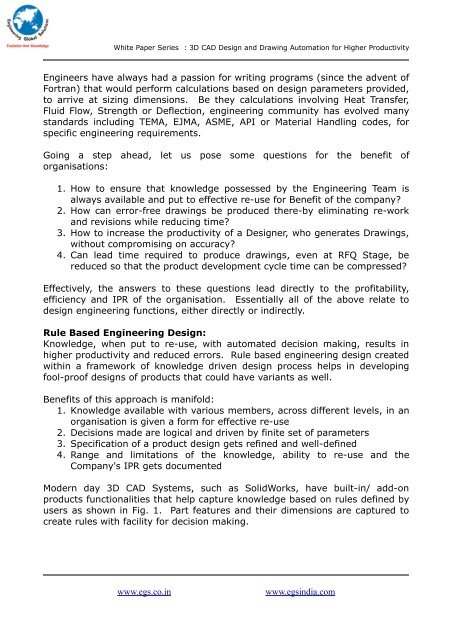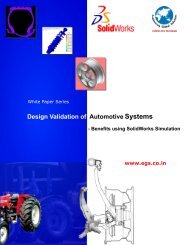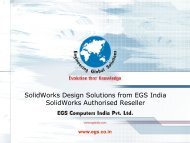Design and Drawing Automation using 3D CAD - EGS Computers
Design and Drawing Automation using 3D CAD - EGS Computers
Design and Drawing Automation using 3D CAD - EGS Computers
You also want an ePaper? Increase the reach of your titles
YUMPU automatically turns print PDFs into web optimized ePapers that Google loves.
White Paper Series<br />
: <strong>3D</strong> <strong>CAD</strong> <strong>Design</strong> <strong>and</strong> <strong>Drawing</strong> <strong>Automation</strong> for Higher Productivity<br />
Engineers have always had a passion for writing programs (since the advent of<br />
Fortran) that would perform calculations based on design parameters provided,<br />
to arrive at sizing dimensions. Be they calculations involving Heat Transfer,<br />
Fluid Flow, Strength or Deflection, engineering community has evolved many<br />
st<strong>and</strong>ards including TEMA, EJMA, ASME, API or Material H<strong>and</strong>ling codes, for<br />
specific engineering requirements.<br />
Going a step ahead, let us pose some questions for the benefit of<br />
organisations:<br />
1. How to ensure that knowledge possessed by the Engineering Team is<br />
always available <strong>and</strong> put to effective re-use for Benefit of the company<br />
2. How can error-free drawings be produced there-by eliminating re-work<br />
<strong>and</strong> revisions while reducing time<br />
3. How to increase the productivity of a <strong>Design</strong>er, who generates <strong>Drawing</strong>s,<br />
without compromising on accuracy<br />
4. Can lead time required to produce drawings, even at RFQ Stage, be<br />
reduced so that the product development cycle time can be compressed<br />
Effectively, the answers to these questions lead directly to the profitability,<br />
efficiency <strong>and</strong> IPR of the organisation. Essentially all of the above relate to<br />
design engineering functions, either directly or indirectly.<br />
Rule Based Engineering <strong>Design</strong>:<br />
Knowledge, when put to re-use, with automated decision making, results in<br />
higher productivity <strong>and</strong> reduced errors. Rule based engineering design created<br />
within a framework of knowledge driven design process helps in developing<br />
fool-proof designs of products that could have variants as well.<br />
Benefits of this approach is manifold:<br />
1. Knowledge available with various members, across different levels, in an<br />
organisation is given a form for effective re-use<br />
2. Decisions made are logical <strong>and</strong> driven by finite set of parameters<br />
3. Specification of a product design gets refined <strong>and</strong> well-defined<br />
4. Range <strong>and</strong> limitations of the knowledge, ability to re-use <strong>and</strong> the<br />
Company's IPR gets documented<br />
Modern day <strong>3D</strong> <strong>CAD</strong> Systems, such as SolidWorks, have built-in/ add-on<br />
products functionalities that help capture knowledge based on rules defined by<br />
users as shown in Fig. 1. Part features <strong>and</strong> their dimensions are captured to<br />
create rules with facility for decision making.<br />
www.egs.co.in<br />
www.egsindia.com




